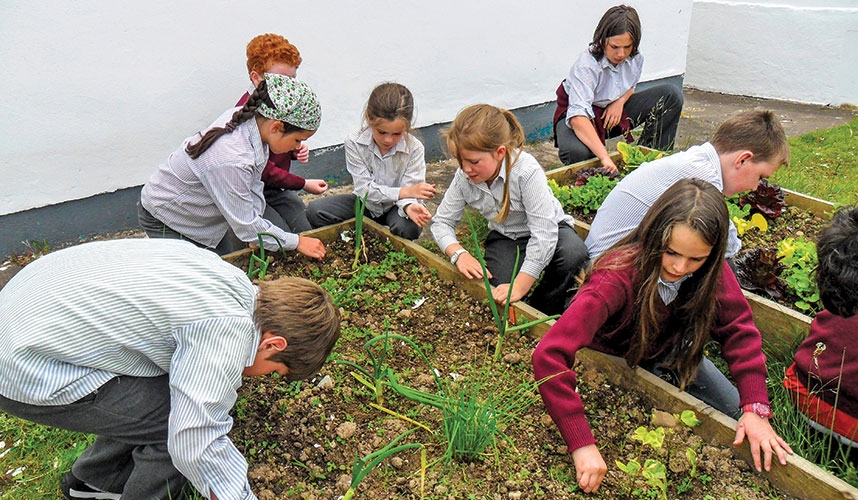We are in danger of suffering a deep disconnect from nature and from the earth. My children and their friends are more skilled at creating gardens on computer game, Minecraft, than they are at planting and growing things in their own garden. Much as I try and involve them in sowing and harvesting fruit and vegetables from our back yard, the twelve year old finds it all mind-numbingly boring and the seven year old would rather kick a football through the bean tepee than tie in the loose shoots. It’s incredibly frustrating; I want to encourage a level of self-sufficiency in my boys. I want them to be able to plant and grow a garden as I think these are vital skills for life but what can I do if they are just not interested?
Enter school. My eldest came home last month with a big grin on his face and a battered and wonky pizza in his outstretched palms. His teacher had had the inspired idea to bring the concept of fork to plate into their classroom. My son and his peers had grown tomatoes and herbs on a windowsill in the classroom and when they were ready to harvest, each child had fashioned him or herself a pizza using homegrown toppings. Next term, he tells me they are going to develop the small orchard area already in the school garden, adding heritage varieties. I am preparing myself for the crumbles and tarts that will wend their way home in his tender care.
HEALTHY AND CONNECTED
How did the school manage to make growing exciting when I couldn’t and why is it important to teach our children these skills? My children spend around half their waking hours at school. In order to become healthy, connected young people, they need access to the land, to have the experience of growing things and to have their hands in the earth.
Raymond Blanc, renowned French chef agrees with me. He recently called for lessons in gardening to be made compulsory to give children the chance to learn about fresh ingredients and healthy eating. ‘We have a wonderful opportunity to truly reconnect with food,’ enthuses Blanc. ‘We need to engage with the outside world, with our gardens and the life within them. Children need to learn the simple magic of taking food from the seed, from the earth or from the rivers and then to transform it into something simple and delicious.’
FOCUS ON DIVERSITY
Fortunately, many teachers share this evangelism about vegetables and the land. Pioneering head, Richard Dunne of Ashley Primary School in Surrey believes that in order to really enjoy food, children need to be involved in all stages of production. It is this belief that led him and his staff to completely revise the whole school’s approach to food and its provision. ‘To enjoy good quality, nutritious food, children need to really understand it, so we wanted to see how much food we could grow on site,’ Dunne explains. He has taken it a step further than my son’s school and the pupils now grow a huge variety of produce on site. ‘We now have extensive food growing areas with a strong focus on diversity. We are currently growing 14 varieties of potato, we have a Surrey apple orchard and last autumn we planted a pear orchard with 21 varieties of pear.’ Dunne was keen to overhaul the whole system and make more of the children’s relationship to the land. ‘We wanted food to be an integral part of our community and culture, not a functional activity that takes place at lunchtime and then is quickly forgotten,’ he explains.
So far so good but how involved are the children when they have exams to prepare for and other subjects to study? Dunne feels that the art of gardening and tending to the land will serve them well in all areas of the curriculum so he has committed to more time for the pupils to spend managing the land. ‘We wanted our children to become fully-fledged experts, so each year group has an area of responsibility,’ he explains. ‘Year 1 pupils learn about and plant wild flowers; year 2 keep bees; year 3 become experts in fruit trees and local varieties of fruit; year 4 look after the soft fruit; year 5 raise the salads; year 6 are in charge of the vegetables. And because the school kitchen uses the children’s produce, they are always excited about eating it.’
START PRODUCING
It brings me back to one of my favourite quotes from Tom Hogkinson, that in order to live a free and simple life, one must stop consuming and start producing. And how inspiring that this is happening at schools across the country. At Iona School in Nottingham the land is a vital part of the school experience. The whole school regularly spends three days on the land, working the allotments, pruning trees and harvesting fruit. I love that part of the land remains wild so that children get to roam free in untamed nature and that families can use the space for birthday parties and other celebratory occasions. Parents can get fully involved in working the gardens with their children and are encouraged to gather at weekends to work and sow seeds.
In Sussex, another Steiner school has a similar policy. At Michael Hall school the children tend over two acres of walled gardens. Julie Ruse, spokesperson for the school explains; ‘We grow about a hundred varieties of vegetables, herbs, flowers, and top fruit, all to Demeter standards.’ And they don’t stop there. Because the garden is biodynamic, compost is vital to the closed loop system. ‘We maintain a variety of compost heaps around the garden. We have two old fashioned wooden greenhouses, three polytunnels, and the original Victorian propagation houses,’ says Ruse. The children learn how to make nettle, comfrey and compost teas to maintain plant health. Part of the garden is set aside for gardening teaching; there is a classroom dedicated to plant growing studies, a propagation house for the children, a bread-baking oven, and tools for garden and woodland crafts. In winter, pupils use the Michael Hall estate to learn about woodland management.
CONNECTING COMMUNITY
Self-sufficiency studies are taken to the next level. ‘The nine year olds have a year of regular farming lessons, some of which are spent in the garden,’ says Ruse. ‘Activities include sowing, harvesting, threshing and milling wheat, before finally baking it into bread.’ This involvement in the land doesn’t stop as the children get older and perhaps need to spend more time on academic work. Surprisingly, growing things becomes even more vital. ‘Between the ages of 11 and 14, pupils have gardening lessons every week, planning and growing their gardens,’ says Ruse. These gardens provide a classroom for all ages and are even used to teach business skills and economy as part of the land forms a thriving productive market garden. ‘We have our own Garden Shop which sells seasonal vegetables and fruit,’ Ruse explains. ‘The aim is to combine beauty in the garden with growing an abundance of good biodynamic vegetables for the school canteen, the garden shop and the local community.’
The benefits to this approach to food and land in schools are widespread. Howarth Primary School in West Yorkshire placed food, gardening and nutrition at the centre of school life, making cookery part of the curriculum and setting up a gardening club providing evening food-planting sessions. Three years after they started this initiative, school meal take-up had risen by 50 per cent and the school’s Sat results had soared.
I am not so concerned about the exam results but if my sons can benefit from Dunne’s assertion that in growing things, ‘children are being given an education in good food that will keep them going throughout their adult lives,’ that makes me happy. And of course, for me, there are crumbles involved too!
MORE INSPIRATION
VISIT theionaschool.org.uk
EXPERIENCE Llearn about Steiner education firsthand. michaelhall.co.uk
READ The Living Lab project at Ashley School demonstrates their whole curriculum approach to the land ashleyschool.org.uk/school-life/the-living-lab-project
This article was first published in The Green Parent Issue 61. To read content from all our back issues subscribe to our digital editions and get full access to our archive.







